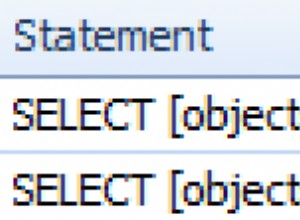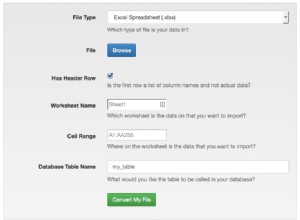अगर आपके PK IDENTITY हैं कॉलम, आप MERGE . वाली तकनीक का उपयोग कर सकते हैं जिसका वर्णन यह प्रश्न
।
यहां बताया गया है कि पूरी प्रक्रिया को कैसे स्क्रिप्ट किया जा सकता है:
DECLARE @OldID int, @NewID int;
SET @OldID = some_value;
DECLARE @TwoMapping TABLE (OldID int, NewID int);
DECLARE @ThreeMapping TABLE (OldID int, NewID int);
INSERT INTO One
SELECT columns
FROM One
WHERE OneID = @OldID;
SET @NewID = SCOPE_IDENTITY();
/*
That one was simple: one row is copied, so just reading SCOPE_IDENTITY()
after the INSERT. The actual mapping technique starts at this point.
*/
MERGE Two tgt
USING (
SELECT
@NewID AS OneID,
other columns
FROM Two t
WHERE OneID = @OldID
) src
ON 0 = 1
WHEN NOT MATCHED THEN
INSERT (columns) VALUES (src.columns)
OUTPUT src.TwoID, INSERTED.TwoID INTO @TwoMapping (OldID, NewID);
/*
As you can see, MERGE allows us to reference the source table in the
OUTPUT clause, in addition to the pseudo-tables INSERTED and DELETED,
and that is a great advantage over INSERT and the core of the method.
*/
MERGE Three tgt
USING (
SELECT
map.NewID AS TwoID,
t.other columns
FROM Three t
INNER JOIN @TwoMapping map ON t.TwoID = map.OldID
) src
ON 0 = 1
WHEN NOT MATCHED THEN
INSERT (columns) VALUES (src.columns)
OUTPUT src.ThreeID, INSERTED.ThreeID INTO @ThreeMapping (OldID, NewID);
/*
Now that we've got a mapping table, we can easily substitute new FKs for the old
ones with a simple join. The same is repeated once again in the following MERGE.
*/
MERGE Four tgt
USING (
SELECT
map.NewID AS ThreeID,
t.columns
FROM Four t
INNER JOIN @ThreeMapping map ON t.ThreeID = map.OldID
) src
ON 0 = 1
WHEN NOT MATCHED THEN
INSERT (columns) VALUES (src.columns);
/*
The Four table is the last one in the chain of dependencies, so the last MERGE
has no OUTPUT clause. But if there were a Five table, we would go on like above.
*/
वैकल्पिक रूप से आपको शायद कर्सर का उपयोग करना होगा, जो SQL सर्वर 2005 और पुराने संस्करणों में ऐसा करने का एकमात्र (समझदार) तरीका प्रतीत होता है।




